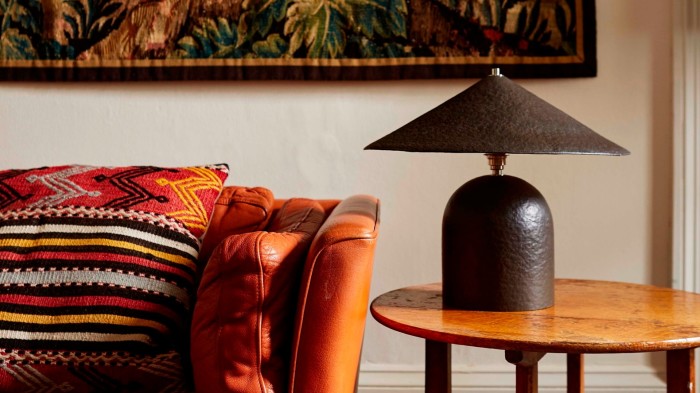Six years ago, designer Vaishnavi Walvekar was walking through a bazaar in Delhi when a bowl caught her eye. Picking it up, she was surprised by its lightness. “It was Kashmiri papier-mâché,” she says, describing how artisans in the disputed Asian region have created wares from waste paper pulp and rice flour for hundreds of years. Intrigued, she asked the market trader how she could learn the craft herself: “He said, ‘Come to Kashmir, and you can work with me.’ And that’s precisely how my journey started.”
Mention papier-mâché and most people will think of misshapen creations pasted around balloons by schoolchildren. Luxury papier-mâché may sound like an oxymoron. But in the hands of contemporary designers such as Walvekar, the craft is being reinvigorated. Their furniture and homeware constructed in paper pulp (“papier-mâché” is simply “chewed paper”) draw on the material’s long history to embrace both its sculptural potential and sustainability credentials.
Walvekar now creates her own papier-mâché works under the name Vāhe Ensemble: mirrors, sculptures, lamps and seating in organic, colourful and often rippling forms, all made from Delhi’s waste office stationery. While Kashmiri papier-mâché uses clay moulds to produce hollow forms, Walvekar builds her pieces freehand in layer upon layer of paper pulp. The results are robust: “People aren’t aware of how rock solid papier-mâché can be,” she says.

This solidity is being explored in myriad ways. For Hermès, Indian architect Bijoy Jain designed an elegant, curved armchair using painted papier-mâché that appears almost like carved stone. At this year’s Milan Design Week, Italian designer Jonathan Bocca exhibited his playful, often zoomorphic, papier-mâché furniture, including a deep-red standing lamp inspired by a two-headed mythological creature. And as part of the London Design Biennale this month, suspended “clouds” in pulped washi paper by Tokyo architecture studio Kuma Lab rise up a grand staircase at Somerset House, exploring the theme of “lightness”.
“To some people it looks like ceramic, to others like plaster; one person thought it was leather,” says Rowena Morgan-Cox, founder of London-based design studio Palefire, of the recycled paper pulp she crafts into a range of lighting. The paper is injected into moulds and air-dried to create wall, floor and table lamps, combining modernist shapes with expressive hand-painted decoration.


Bocca also uses waste paper, a byproduct of the paper industry in his Tuscan hometown of Lucca. The inspiration for his colourful chairs, tables and lamps, meanwhile, comes from another local source: the traditional papier-mâché floats of the Viareggio Carnival, crafted in the centuries-old “cartapesta” technique (covering clay moulds with layers of paper and glue) adopted by Renaissance sculptors. Bocca’s method may differ — he mixes his paper pulp with glue before applying it to wire mesh stretched over a wooden frame — but the appeal remains the same: it can create almost endless shapes and forms.
It’s also eminently recyclable. “Papier-mâché is a very circular production method,” says Walvekar. “You can literally break it down, put it back in the water and reuse it.” Bocca does the same when he’s not happy with a design: “We put it in a bathtub for three days, take out the paper and start working on it again.” But that susceptibility to water means that these are not designs suited to splashy bathrooms or outdoor spaces.


Adaptations are allowing the material to achieve new potential, however. London-based designer BC Joshua has added strength and resilience by combining recycled paper with ground-up salvaged plasterboard. In his furniture and lighting, the material appears like rough-hewn stone, out of which emerge minimal wooden or metal elements, often in vibrant shades.
Kuma Lab, founded by award-winning architect Kengo Kuma at the University of Tokyo in 2009 to research materials, has come up with a specialised mineral coating. Applied to washi paper pulp, it renders the material “virtually weatherproof”, says co-director Toshiki Hirano. In 2022, the studio mounted a large and rippling, ribbonlike sculpture, “hida-hida”, on the facade of the Tokyo University of the Arts’ Hisao & Hiroko Taki Plaza building, designed by Kengo Kuma & Associates. The work has “already survived typhoons, snowstorms and the city’s humid summers”, says Hirano.

“Paper pulp, when manipulated properly, has surprising strength and versatility,” says Hirano. “I see enormous potential in developing systems where paper pulp can be cast, pressed or even 3D printed. By controlling its thickness, layering and geometry, it can move beyond being a surface treatment and start to behave like a spatial material.” Hirano and his team have been researching how to use paper pulp structurally in buildings.
But while such projects may seem to force paper to perform as if it were stone, wood, clay or metal, its specific qualities remain celebrated. “I’m drawn to the uneven, organic texture of washi paper,” says Hirano. “It brings rhythm, softness and unpredictability.”
“Paper Clouds” is this year’s Japan Pavilion at the London Design Biennale, Somerset House, until June 29; londondesignbiennale.com; Kengo Kuma will give the LDB keynote at King’s College on June 10
Find out about our latest stories first — follow House & Home on Instagram, and sign up to receive our House & Home Unlocked newsletter every Friday




